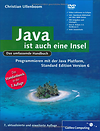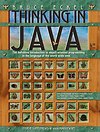Rails-powered Open Source Killer Apps, Anyone?
Gute Sammlung an Open-Source-Rails-CMS und Diskussion darüber, warum es relativ wenige davon gibt.
Gute Sammlung an Open-Source-Rails-CMS und Diskussion darüber, warum es relativ wenige davon gibt.
 Kleine Einführung in Ruby. Variablen, Bedingungen, Schleifen, Hashes, Objekte, Module, Exceptions, Reguläre Ausdrücke, ...
Begleit-PDF zum Buch [Rapid Web Development mit Ruby on Rails](http://www.amazon.de/exec/obidos/ASIN/3446414983/dierobsite-21).
Kleine Einführung in Ruby. Variablen, Bedingungen, Schleifen, Hashes, Objekte, Module, Exceptions, Reguläre Ausdrücke, ...
Begleit-PDF zum Buch [Rapid Web Development mit Ruby on Rails](http://www.amazon.de/exec/obidos/ASIN/3446414983/dierobsite-21).
Wer Java lernen will oder muss, braucht Tutorials. Wer lieber Bücher mag, braucht Geld. Gratis Java-Bücher lösen beide Probleme:
 Handbuch der Java-Programmierung von Guido Krüger & Thomas Stark, 2007
Handbuch der Java-Programmierung von Guido Krüger & Thomas Stark, 2007
Sehr umfangreich. Gutes Einsteiger-Tutorial sowie Referenz. Behandelt Java 1.5 und wird oft geupdatet.
Papierversion bei Amazon kaufen - 1280 Seiten, ~50 €
 Java ist auch eine Insel von Christian Ullenboom, 2007
Java ist auch eine Insel von Christian Ullenboom, 2007
Die Einführung in die Sprache Java ist anschaulich und immer praxisorientiert. Schnell geht es weiter mit fortgeschrittenen Themen wie Threads, Swing, Netzwerkprogrammierung, Java Beans, RMI, XML und Java, Servlets und Java Server Pages, JDBC und vielem mehr.
Papierversion bei Amazon kaufen - 1464 Seiten, ~50 €
 Introduction to Programming Using Java von David J. Eck, 2006
Introduction to Programming Using Java von David J. Eck, 2006
Gut für komplette Programmieranfänger, die gleichzeitig Java lernen wollen. Behandelt all die Grundlagen sowie Netzwerk. und GUI-Programmierung.
Nur online, als HTML oder PDF.
 Thinking in Java, dritte Auflage von Bruce Eckel, 2002
Thinking in Java, dritte Auflage von Bruce Eckel, 2002
Gut geschrieben, ausführlich, aber eher für Leute mit etwas Programmiererfahrung (nicht unbedingt in Java).
Die neueste, vierte, Auflage bei Amazon kaufen - 1150 Seiten, ~45 €
 [CakePHP](http://cakephp.org/) ist ein gutes PHP-Webframework, dass sich anfangs eine Menge von Ruby on Rails abgeguckt hat. Somit kann man Webapps schnell entwickeln und dank PHP auch auf billigen Shared-Hosting-Paketen zum laufen bringen.
[CakePHP](http://cakephp.org/) ist ein gutes PHP-Webframework, dass sich anfangs eine Menge von Ruby on Rails abgeguckt hat. Somit kann man Webapps schnell entwickeln und dank PHP auch auf billigen Shared-Hosting-Paketen zum laufen bringen.
Nicht übermäßig performant und (PHP-bedingt) umständlicher als Rails, machts trotzdem eine Menge Spaß Zeug damit zu bauen. Ich hab zumindest schon zwei kleine Seiten damit entwickelt und kann es nur empfehlen, wenn Rails keine Option ist.
Nettuts Tutorials erklären die Grundlagen von Cake.
Hier noch eine deutsche Tutorialserie von Thomas Diehl, in der ein kleines Blog gebaut wird:
Nicht zu vergessen die CakePHP Doku und die gutbesuchte CakePHP Google Group.
 Zusammen mit [Miro](http://www.getmiro.com/) mein Ersatz fürs Fernsehen.
Zusammen mit [Miro](http://www.getmiro.com/) mein Ersatz fürs Fernsehen.
 Kleines Netlabel für 8 Bit, Chiptunes, Elektro, ...
Kleines Netlabel für 8 Bit, Chiptunes, Elektro, ...
...influenced by electronic, 8 bit, Easy-Listening, Acid, Toyz-Pop, Breackore, Electro Surf, Electro bass, Miami Bass ... any music style is welcome..My primary goal is to promote new bands and music styles.
Wie vor 44 Monatan angekündigt ist die neue Robsite nun fertig.
Es ist ein Neuanfang. Ich hab wenig alten Content übernommen, hauptsächlich, weil er mich nicht mehr interessierte oder die Links gestorben sind.
 Nach Monaten des Kopfzerbrechens über das Konzept der neuen Seite, war mir klar, dass die Robsite eigentlich immer nur ein ordinäres Blog war. Mit Linkarchiv. In Blau. Somit ist die neue Robsite nichts weiter als das. Das dreimilliardste Blog. Mein Blog. Ernüchternd, aber auch befreiend.
Hätte deshalb eigentlich Roblog heissen müssen, aber auf die [Idee](http://www.google.com/search?q=roblog&hl=en) sind auch schon einige tausend Geeks gekommen.
Nach Monaten des Kopfzerbrechens über das Konzept der neuen Seite, war mir klar, dass die Robsite eigentlich immer nur ein ordinäres Blog war. Mit Linkarchiv. In Blau. Somit ist die neue Robsite nichts weiter als das. Das dreimilliardste Blog. Mein Blog. Ernüchternd, aber auch befreiend.
Hätte deshalb eigentlich Roblog heissen müssen, aber auf die [Idee](http://www.google.com/search?q=roblog&hl=en) sind auch schon einige tausend Geeks gekommen.
Seit den Tagen der alten Robsite haben sich meine Interessen leicht verschoben. Ich bin von Windows auf Mac gewechselt, interessier mich mehr für Ruby und Webentwicklung statt *Basic und Spieleentwicklung und fang langsam an Musik am Rechner zu machen. Dies alles, neben diversem lustigem Zeug, wird also die Seite füllen. Oder auch nicht. Je nachdem.
Ruby on Rails ist derweil die Technik meiner Wahl um Webzeug zu basteln. In den Semesterferien hab ich mich mit wenig anderem beschäftigt und die Robsite mit Rails neugebaut. Was ich dabei gelernt hab, werd ich nach und nach hier veröffentlichen. Die neue Seite mag zwar schlicht aussehen, aber der Adminbereich hats in sich. Simpel aber mächtig. Wie George W. Bush.
 Warum nun Rails statt PHP? Vor allem Spaß. Spaß bei der Arbeit = höhere Produktivität, Qualität und Motivation. Entweder du schaffst in gleicher Zeit mehr und bessere Ergebnisse, oder du schaffst gleiche Ergebnisse in weniger Zeit. Es ist einfach keine lästige Arbeit, wenn es Spaß macht. Und das motiviert :>
Warum nun Rails statt PHP? Vor allem Spaß. Spaß bei der Arbeit = höhere Produktivität, Qualität und Motivation. Entweder du schaffst in gleicher Zeit mehr und bessere Ergebnisse, oder du schaffst gleiche Ergebnisse in weniger Zeit. Es ist einfach keine lästige Arbeit, wenn es Spaß macht. Und das motiviert :>
Bis sich mein Domainhoster auskäst und robsite.de auf meinen neuen Hoster überträgt, erfolgt die Weiterleitung auf robsite.net mit einer .htaccess. Das heisst, robsite.de wird demnächst kurz offline gehen. robsite.net sollte aber weiterlaufen, solange mein kleiner vServer bei Slicehost nicht aufgibt.
Andererseits hab ich eh nur noch 3 Besucher pro Tag, also betriffts sowieso keinen (img 358 t:big)